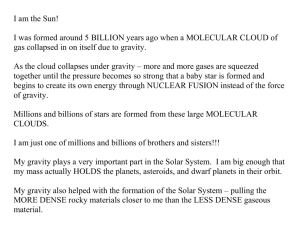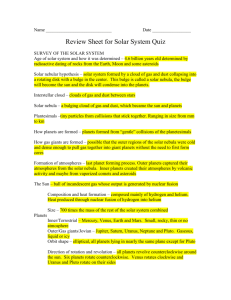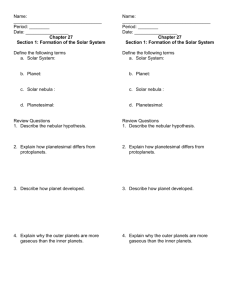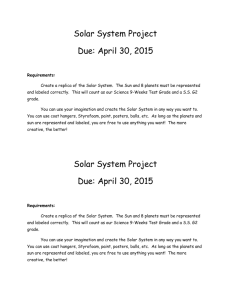Structure & Formation of the Solar System
advertisement
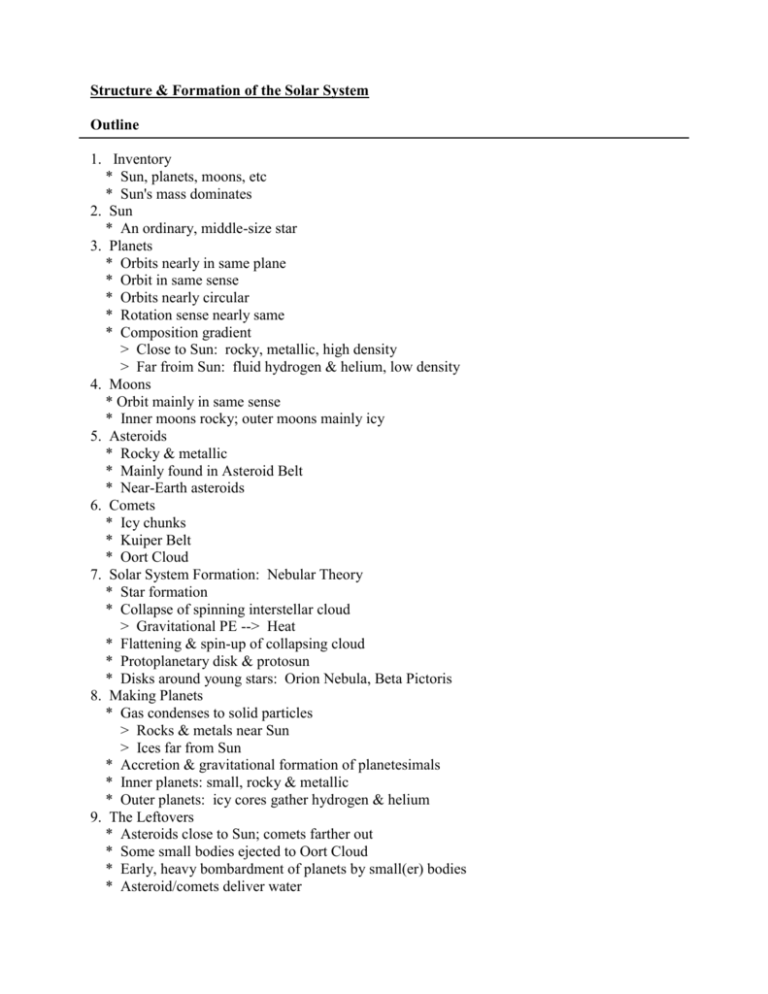
Structure & Formation of the Solar System Outline 1. Inventory * Sun, planets, moons, etc * Sun's mass dominates 2. Sun * An ordinary, middle-size star 3. Planets * Orbits nearly in same plane * Orbit in same sense * Orbits nearly circular * Rotation sense nearly same * Composition gradient > Close to Sun: rocky, metallic, high density > Far froim Sun: fluid hydrogen & helium, low density 4. Moons * Orbit mainly in same sense * Inner moons rocky; outer moons mainly icy 5. Asteroids * Rocky & metallic * Mainly found in Asteroid Belt * Near-Earth asteroids 6. Comets * Icy chunks * Kuiper Belt * Oort Cloud 7. Solar System Formation: Nebular Theory * Star formation * Collapse of spinning interstellar cloud > Gravitational PE --> Heat * Flattening & spin-up of collapsing cloud * Protoplanetary disk & protosun * Disks around young stars: Orion Nebula, Beta Pictoris 8. Making Planets * Gas condenses to solid particles > Rocks & metals near Sun > Ices far from Sun * Accretion & gravitational formation of planetesimals * Inner planets: small, rocky & metallic * Outer planets: icy cores gather hydrogen & helium 9. The Leftovers * Asteroids close to Sun; comets farther out * Some small bodies ejected to Oort Cloud * Early, heavy bombardment of planets by small(er) bodies * Asteroid/comets deliver water Questions 1. Ques. #2, pg. 137. 2. Ques. #3, pg. 137. 3. Ques. #4, pg. 137. 4. Ques. #5, pg. 137. 5. Ques. #7, pg. 137. 6. Ques. #9, pg. 137. 7. Ques. #10, pg. 137. 8. Ques. #11, pg. 137. 9. Ques. #14, pg. 137. 10. Prob. #2, pg. 138. Answers 1. Planets all revolve around Sun in same sense (counterclockwise as viewed from above Earth's north pole). Most (but not all) planets rotate in the same counterclockwise sense. Most moons of planets revolve in the same counterclockwise sense. 2. Terrestrial: high density, small, rocky/metallic. Jovian: low density, large, hydrogen/helium. Moon has the same gross properties as terrestrial planets. Pluto is neither terrestrial nor Jovian: it's small, but its density is relatively low (~ 2 g/cm3). It's probably made mostly of ice, with some rocky stuff mixed-in - rather like an enormous comet nucleus. 3. Asteroids are small (few miles to a few hundred miles in diameter), rocky/metallic objects orbiting the Sun, mainly in the region between the orbits of Mars and Jupiter. Comets are small (few miles in diameter) icy bodies, orbiting the Sun. Orbit planes of Kuiper belt comets are near the central plane of the solar system; orbit planes of Oort cloud comets lie at a variety of angles to the central plane of solar system. Oort cloud comet orbits effectively fill a sphere centered on the Sun, with radius of about 100,000 AU. 4. The 'challenges' are well-summarized on pgs. 124 - 125 in the text. 5. The solar system formed out of an interstellar cloud that was initially spinning. This cloud began to collapse due to its own gravitation. As it collapsed, it also flattened into a rather thin disk. Material falling in at a right angle to cloud rotation axis has a relatively hard time collapsing: Imagine yourself on a spnning playground merry-go-round. As you spin, you feel as if some force is trying to push you away from the center of the merry-go-round; so it is also with material trying to fall in toward the rotation axis of the collapsing solar nebula. On the other hand, material falling inward along the rotation axis, feels no such repulsive force - thus falls in much faster. Thus, we get a disk. We observe disks surrounding stars and stars-in-the-making (protostars) outside our own solar system today. This leads us to believe our own solar system grew out of disk surrounding the Sun in the distant past. 6. Near the protosun, where it was hot, only materials with high condensation temperatures could condense out of the gas of the solar nebula. This would include rocky and metallic stuff. Materials that condense to form ices (various compounds of hydrogen, like water), could condense only in the relatively low temperature conditions far from the protosun. So, near the Sun, we have planets that are rocky and metallic. Furthermore, the original solar nebula probably contained only a small quantity of this dense stuff; thus the inner (terrestrial) planets are rather small. Far from the protosun, in the cooler regions of the solar nebula, ices could form, and because hydrogen would have been plentiful in the solar nebula, very large lumps of ice could form (with some rocky & metallic stuff mixed-in, too). These lumps of ice then proceeded to gather-in remaining hydrogen (and helium) gas in the nebula, giving them thick mantles of hydrogen and helium. This is how we believe the Jovian planets were made. 7. Accretion is the process of building-up large bodies from small ones. Accretion occurs by direct collision and sticking-together of small bodies, and, via gravitaional attraction as the bodies become larger. 8. Part of this question is addressed in #6, above. As to how nebular capture explains the large number of moons around the Jovian planets: In the course of nebular capture, each of the Jovian planets repeated the larger pattern for formation of the solar system as a whole: the formation of a disk of gas surrounding a central, massive objects. It is within these disks surrounding the newborn Jovian planets that we believe many of their moons were formed, much like the formation of the planets themselves in the larger solar nebula. 9. Impacts were more common because there were many more impactors! The remnants of these impactors became our present-day asteroids and comets Eventually, the number of impactors greatly decreased as they collided with the planets. A planetary surface that is heavily cratered (like the lunar highlands) probably dates from the early era of heavy bombardment. A more lightly cratered surface is probably younger; its few craters indicate a later era in which the cratering rate had greatly decreased. Thus younger planetary surfaces are generally regarded as younger (in the sense of having formed more recently) than heavily cratered surfaces. 10. At 50 K, ices would have readily formed in the inner regions of the solar system, and these ices would have occured in abundance. Large quantities of ice would have been incorporated into the terrestrial planets, which would have ended-up larger than at present. Because the ices would have contributed relatively low density material, the densities of the terrestrial planets would be smaller than at present.




